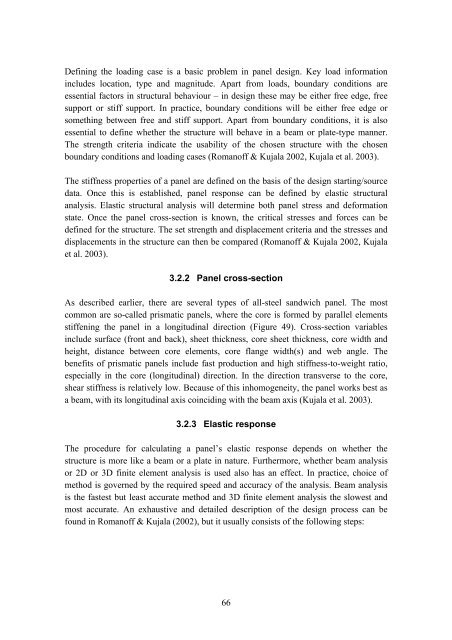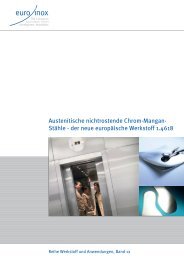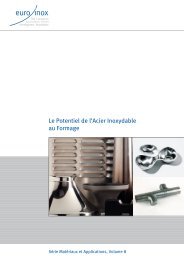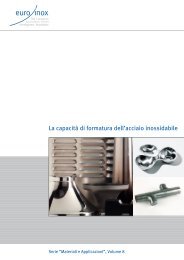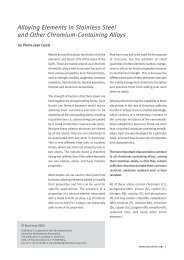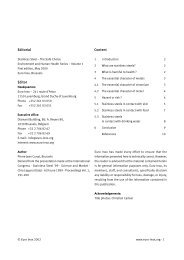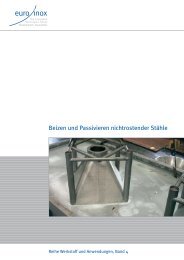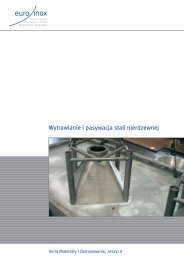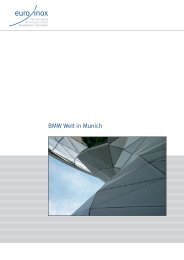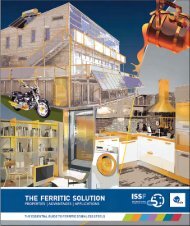Innovative Stainless Steel Applications in transport ... - Euro Inox
Innovative Stainless Steel Applications in transport ... - Euro Inox
Innovative Stainless Steel Applications in transport ... - Euro Inox
Create successful ePaper yourself
Turn your PDF publications into a flip-book with our unique Google optimized e-Paper software.
Def<strong>in</strong><strong>in</strong>g the load<strong>in</strong>g case is a basic problem <strong>in</strong> panel design. Key load <strong>in</strong>formation<br />
<strong>in</strong>cludes location, type and magnitude. Apart from loads, boundary conditions are<br />
essential factors <strong>in</strong> structural behaviour – <strong>in</strong> design these may be either free edge, free<br />
support or stiff support. In practice, boundary conditions will be either free edge or<br />
someth<strong>in</strong>g between free and stiff support. Apart from boundary conditions, it is also<br />
essential to def<strong>in</strong>e whether the structure will behave <strong>in</strong> a beam or plate-type manner.<br />
The strength criteria <strong>in</strong>dicate the usability of the chosen structure with the chosen<br />
boundary conditions and load<strong>in</strong>g cases (Romanoff & Kujala 2002, Kujala et al. 2003).<br />
The stiffness properties of a panel are def<strong>in</strong>ed on the basis of the design start<strong>in</strong>g/source<br />
data. Once this is established, panel response can be def<strong>in</strong>ed by elastic structural<br />
analysis. Elastic structural analysis will determ<strong>in</strong>e both panel stress and deformation<br />
state. Once the panel cross-section is known, the critical stresses and forces can be<br />
def<strong>in</strong>ed for the structure. The set strength and displacement criteria and the stresses and<br />
displacements <strong>in</strong> the structure can then be compared (Romanoff & Kujala 2002, Kujala<br />
et al. 2003).<br />
3.2.2 Panel cross-section<br />
As described earlier, there are several types of all-steel sandwich panel. The most<br />
common are so-called prismatic panels, where the core is formed by parallel elements<br />
stiffen<strong>in</strong>g the panel <strong>in</strong> a longitud<strong>in</strong>al direction (Figure 49). Cross-section variables<br />
<strong>in</strong>clude surface (front and back), sheet thickness, core sheet thickness, core width and<br />
height, distance between core elements, core flange width(s) and web angle. The<br />
benefits of prismatic panels <strong>in</strong>clude fast production and high stiffness-to-weight ratio,<br />
especially <strong>in</strong> the core (longitud<strong>in</strong>al) direction. In the direction transverse to the core,<br />
shear stiffness is relatively low. Because of this <strong>in</strong>homogeneity, the panel works best as<br />
a beam, with its longitud<strong>in</strong>al axis co<strong>in</strong>cid<strong>in</strong>g with the beam axis (Kujala et al. 2003).<br />
3.2.3 Elastic response<br />
The procedure for calculat<strong>in</strong>g a panel’s elastic response depends on whether the<br />
structure is more like a beam or a plate <strong>in</strong> nature. Furthermore, whether beam analysis<br />
or 2D or 3D f<strong>in</strong>ite element analysis is used also has an effect. In practice, choice of<br />
method is governed by the required speed and accuracy of the analysis. Beam analysis<br />
is the fastest but least accurate method and 3D f<strong>in</strong>ite element analysis the slowest and<br />
most accurate. An exhaustive and detailed description of the design process can be<br />
found <strong>in</strong> Romanoff & Kujala (2002), but it usually consists of the follow<strong>in</strong>g steps:<br />
66


